Archaeologists digging at Al-Khazneh, featured in Indiana Jones and the Last Crusade, uncovered an ancient tomb filled with 12 skeletons — and one of them was clutching a vessel that looks remarkably like the Holy Grail depicted in the film.
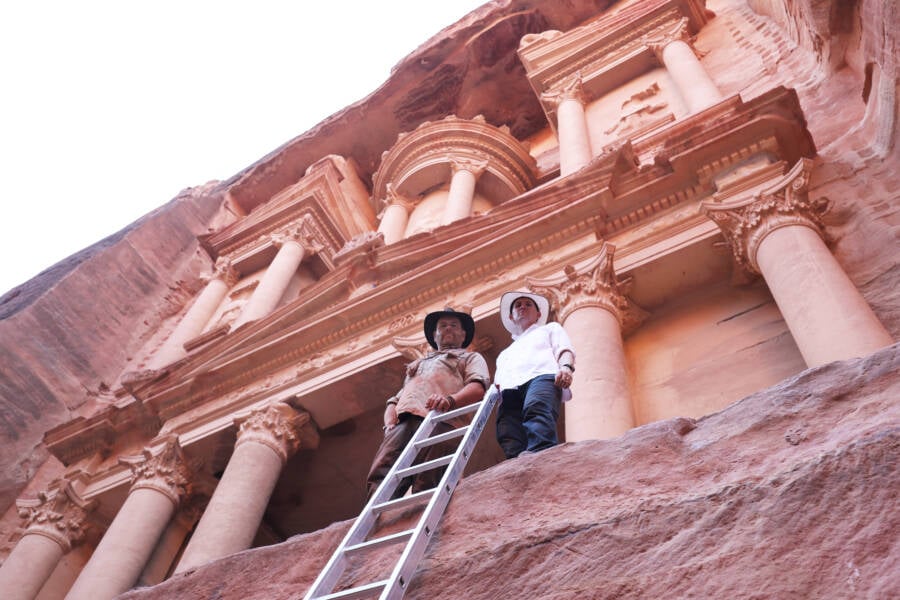
Discovery’s Expedition UnknownExplorer and host Josh Gates with researcher Paul Creasman standing beneath the Treasury of Petra, where a long-hidden tomb was recently uncovered.
Beneath a mysterious, hand-carved structure built into the desert canyon walls in Petra, Jordan, archaeologists have discovered a 2,000-year-old tomb containing 12 skeletons. The structure, known as the Treasury, was famously featured in the 1989 film Indiana Jones and the Last Crusade as the resting place of the Holy Grail.
Known in Arabic as “Al-Khazneh,” or “the treasury of the pharaoh,” the structure’s exact purpose remains unclear. However, earlier this year, a joint team of Jordanian and American researchers were granted permission to excavate beneath the structure, where they discovered the tomb along with various bronze, iron, and ceramic artifacts, including a grail-like object.
Why Archaeologists Have Long Been Fascinated By Petra And The Nabataean Kingdom

Discovery’s Expedition UnknownLeft to right: Dr. Fares Braizat, Fadi Balawi, Josh Gates, and Dr. Pearce Paul Creasman looking into the newly discovered tomb at Petra.
The Treasury has long fascinated archaeologists, well before its appearance in Steven Spielberg’s 1989 film. It sits at the center of an entire city carved by hand into the walls of a desert canyon by the Nabateans and it dates back 2,000 years.
The Nabataean Kingdom was an ancient Arab state that thrived from around the fourth century B.C.E. until its annexation by the Roman Empire in 106 C.E. The kingdom was centered in modern-day Jordan, with its capital in the stunning city of Petra, a remarkable archaeological site known for its rock-cut architecture.
The Nabataeans were master builders and traders, controlling a significant portion of the trade routes that carried goods such as spices, incense, textiles, and precious stones from Arabia, Africa, and India to the Mediterranean world. Their control of trade and their hydraulic engineering innovations, which allowed them to collect and store scarce water in the arid region, were key to their success.
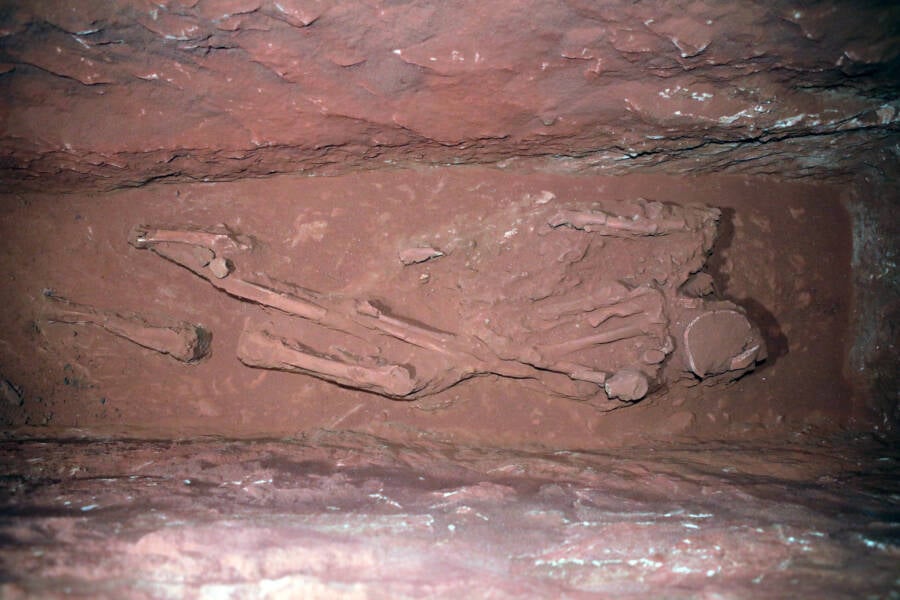
Discovery’s Expedition UnknownA Nabataean skeleton buried beneath the Treasury of Petra.
Petra, often referred to as the “Rose City” due to the color of its sandstone cliffs, was the crown jewel of the Nabataean Kingdom. It was a bustling metropolis filled with grand temples, tombs, and houses carved directly into the rock. The Nabaateans had a remarkable ability to integrate with the local environment, blending elements of Hellenistic, Roman, and Middle Eastern architecture and culture into their city planning and way of life.
The kingdom’s wealth attracted attention, and it became a target for both the Greeks and Romans. In 106 C.E., Emperor Trajan annexed the Nabataean Kingdom into the Roman Empire, turning it into the province of Arabia Petraea. After the annexation, the Nabataeans gradually assimilated into the Roman world, and their distinct culture began to fade.
Despite their eventual fall, the legacy of the Nabataeans endures to this day, particularly through the architectural marvels of Petra, which is now a UNESCO World Heritage Site and one of the most iconic archaeological wonders in the world.
Excavation At Petra’s Treasury Uncovers An Ancient Tomb And Treasure Trove

Discovery’s Expedition UnknownJosh Gates, Paul Creasman, and archaeologist Matthew Vincent excavating the Petra site.
According to a statement from the St. Andrews School of Earth and Environmental Science, the research team was given permission earlier this year to conduct a “remote sensing scan” on Petra’s Treasury.
“The main purpose of the survey was to assess the condition of the areas around the Treasury, its courtyard, the plaza, exit of the Siq and the wadi into which they all feed, in advance of potential future works to divert and better control flood waters,” said professor Richard Bates.
This non-invasive survey revealed possible underground chambers beneath and surrounding the Treasury, prompting the research team to begin more detailed analysis of the site.
The excavation was led by Dr. Pearce Paul Creasman of the American Center of Research. Using ground-penetrating radar, the team identified identical structures on the right side of the Treasury, matching two structures on the left side that were discovered in 2003. This provided them with enough proof to receive permission to dig from the Jordanian government.
Creasman then contacted the Discovery Channel’s Josh Gates, host of Expeditions Unknown, to bring a film crew to the site to document the excavation. During the filming, the team unearthed the ancient tomb and its still-filled chambers containing skeletons — a rarity in Petra.
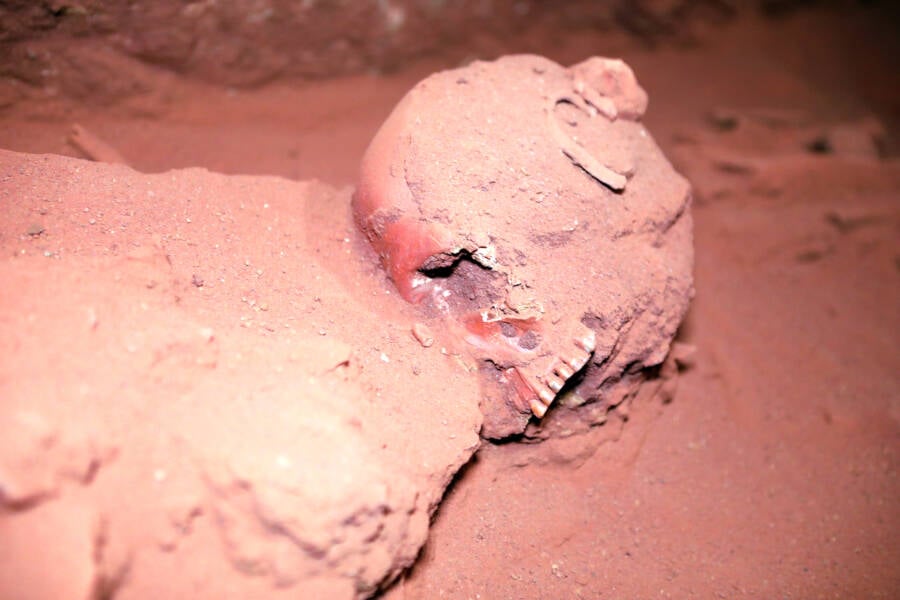
Discovery’s Expedition UnknownThe skull of a long-deceased Nabataean found under the Treasury at Petra.
“The discovery is of international significance as very few complete burials from the early Nabataeans have ever been recovered from Petra before,” said professor Bates. “The burials, their goods, and the human remains can all be expected to help fill the gaps of our knowledge in how Petra came to be and who the Nabataeans were.”
Creasman shared in Bates’ excitement. Two decades ago, when the left-side tomb was discovered beneath the Treasury, researchers only found partial skeletal remains, and the data was never published. Now, the research team has found a wealth of discoveries that can offer more insight into the lives of the Nabataeans.
“We were hopeful to find anything that might tell us more about the ancient people and place — human remains can be a really valuable tool in that regard,” Creasman told CNN. “The burials in this tomb are articulated, so the bones haven’t been rummaged around and moved, so that’s exceedingly rare.”
New Insights Into The Lives Of The Ancient Nabataeans
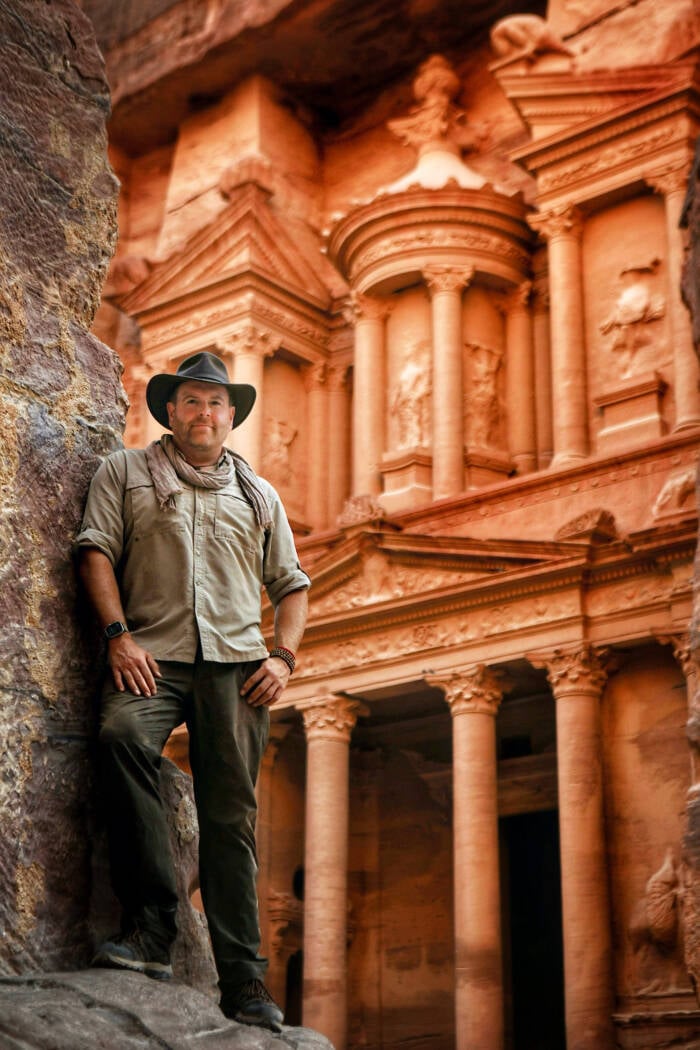
Discovery’s Expedition UnknownJosh Gates at the Treasury of Petra.
The human remains found here are especially rare, as the tombs at Petra had been used and reused over the centuries. Hopefully, with several complete burials found, researchers can begin to answer long-unanswered questions about the Nabataean Kingdom’s culture. In particular, researchers have sought to understand more about Nabataean burial practices — especially the differences between how royals and commoners were buried.
Based on what they have found so far, Creasman said there seems to be little difference in how the two groups were buried, which would align with the more egalitarian culture scholars have long associated with the kingdom. Still, it’s likely that the newly discovered burials were quite important people in their day.
“They must be hugely important people, because where they’re buried is such prime real estate; it really is the main entrance to the city,” Gates said. “I think learning who they are is really going to help unlock part of the story of the Treasury.”
But it’s not just the skeletons that tell the story of the Nabataeans here. In the tomb were also several ancient artifacts, including bronze, iron, and ceramic items. Most shockingly, however, was the discovery of a vessel that looks remarkably similar to the Holy Grail as depicted in Indiana Jones and the Last Crusade.
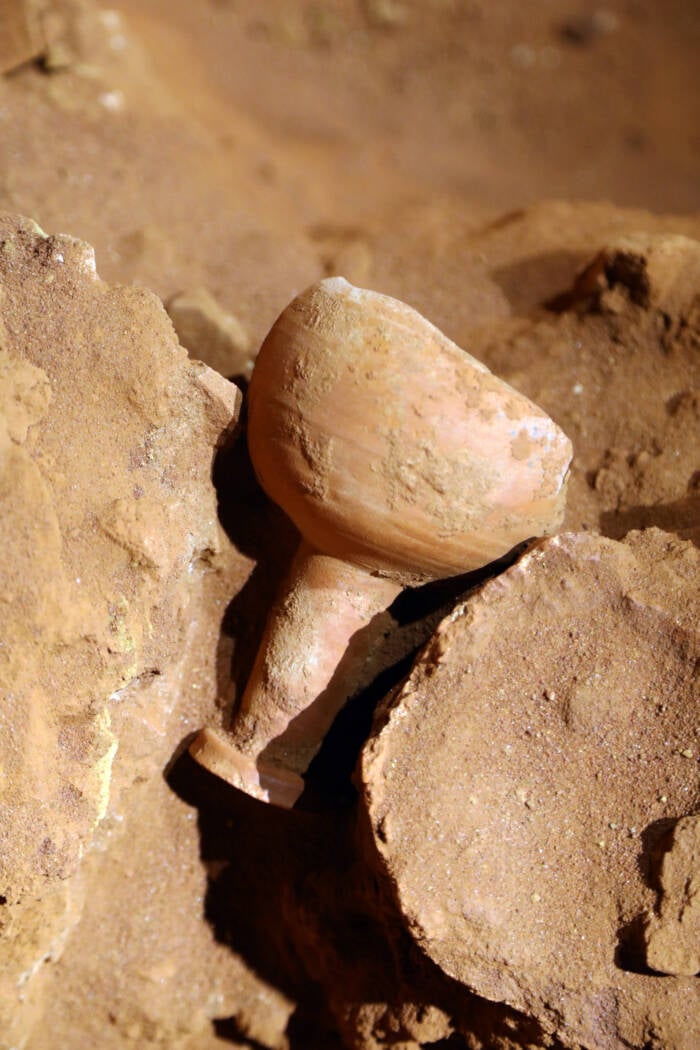
Discovery’s Expedition UnknownA vessel found beneath the Treasury of Petra, shockingly similar to the Holy Grail featured in 1989’s Indiana Jones and the Last Crusade.
“When we spotted what looked like a chalice, all of us just froze,” Gates said. “It looked nearly identical to the Holy Grail featured in Indiana Jones and the Last Crusade, set in the ancient building directly above the tomb. It was the ultimate moment of life imitating art.”
There is still much to learn about Petra’s Treasury, but this new discovery has offered never-before-seen insights into life in the ancient Nabataean Kingdom.
After reading about the excavation of Petra’s Treasury, explore Hegra, the second city of the Nabataean Kingdom. Then, dive into the history of some sunken cities from around the world.





